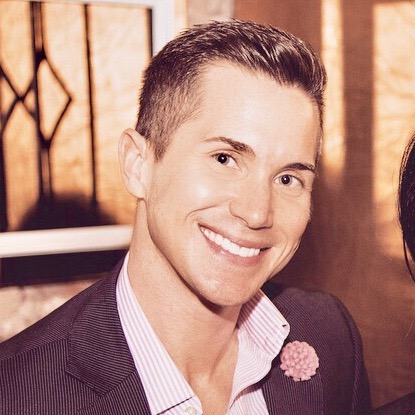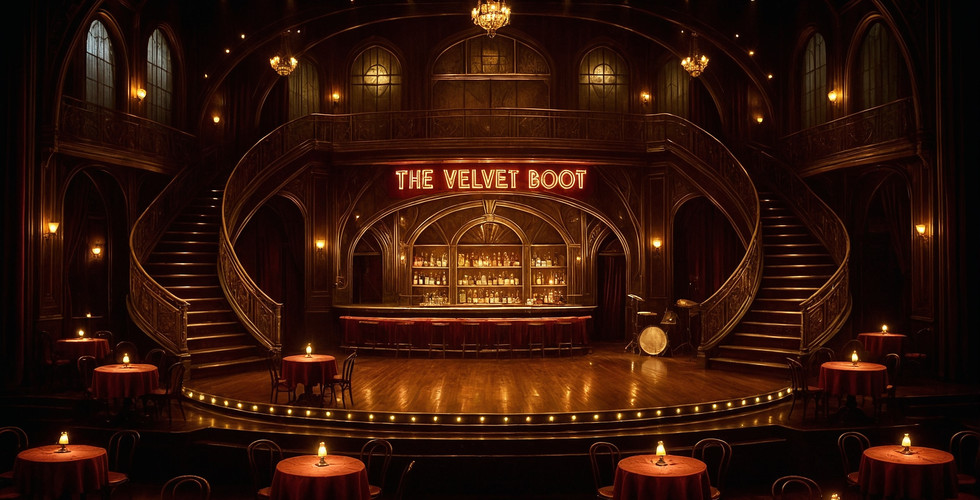🎭 What if Romeo & Juliet Fell in Love in a 1920s Queer Speakeasy?
- Waymon Hudson

- Jul 17
- 7 min read
Updated: Nov 19
What if the world’s most iconic love story was rewritten as a defiant, glittering act of queer rebellion?
Looking for new queer Broadway musicals or LGBTQ+ love stories in theater that break the mold? Speakeasy is my answer – a jazz-drenched, passionately original musical that asks: What if Romeo & Juliet fell in love in a 1920s underground queer speakeasy? This isn’t Shakespeare as you remember. It’s an electrifying reimagining of the star-crossed lovers’ tale, trading Verona’s balconies for the smoky allure of a Prohibition-era Chicago club. If you’re a fan of epic, genre-blending shows like Hadestown, Ragtime, Spring Awakening, or the gritty decadence of Cabaret, Speakeasy will feel like a kindred spirit – even as it sings with a radical voice all its own.
A Romeo & Juliet Reborn in a Queer Speakeasy
In Speakeasy, Shakespeare’s doomed romance is reborn in The Velvet Boot, a hidden jazz club where those cast out by society come to life. Our Juliet is Jules Delaney, the dutiful daughter of a fire-and-brimstone police sergeant and a fervent temperance activist. Our Romeo is Rome Moretti, the poetic son of a bootlegging crime boss. Their worlds collide when Jules slips through a secret door into The Velvet Boot’s kaleidoscope of music and drag, finding a sanctuary of queer joy and freedom. Amid the jazz and clinking glasses, Jules and Rome fall headlong into a “forbidden” love that feels like liberation.
But Speakeasy’s love story doesn’t stop at two star-crossed lovers – it blooms into a whole community. In the shadows stands Merc, Rome’s sharp-witted best friend, who is queer and secretly in love with him. Watching closely is Miss Addie, Jules’s lifelong housekeeper and protector, a Black queer woman who has spent her life surviving in silence. Through Merc’s fierce loyalty and Miss Addie’s quiet strength, the idea of love expands beyond romance to a found family bound by loyalty and hope. Their sacrifices raise the stakes of this tale and expand the love story beyond a couple to a community.
As tensions mount, Speakeasy sweeps from intimate moments to explosive confrontations. The lovers must defy not just their feuding families, but the entire oppressive world outside The Velvet Boot’s walls. Together with their chosen family of outcasts, they challenge the forces of law, prejudice, and legacy that demand silence. The story surges toward a dramatic raid on the speakeasy, a desperate act of rebellion and a heart-wrenching climax. Like its Shakespearean inspiration, Speakeasy doesn’t shy away from tragedy – but it also celebrates the beauty and bravery that bloom in its midst. In this underground club, love becomes an act of resistance, and even as fate closes in, a community rises to declare that their lives, their love, and their joy will not be erased.
Queer Love, Joy, and Revolution on Stage
I began writing Speakeasy not just to set an old love story to jazz, but to ignite a revolution and a revelation. At its core, this musical asks a profound question: What if love could be a revolution? In Speakeasy, queer love isn’t hidden in subtext – it stands center stage, sacred and unapologetic. In a world that punishes tenderness, characters like Merc and Miss Addie show what it means to live, and even die, for the right to be seen. The Velvet Boot isn’t just a club — it’s a sanctuary, a community, a family. Here, music, dance, and drag become radical acts of defiance. The show insists that survival isn’t enough: joy is rebellion, and it must be loud. Every time a character sings, laughs, or loves openly, they are fighting back against a society that would rather erase them.
Speakeasy wears its themes on its sleeve: joy as resistance, visibility as survival, and found family as salvation. Jules’s journey echoes so many queer stories – wrestling with faith and family, breaking free from the shame meant to silence her, and reclaiming her truth from the grip of repression. Rome’s path explores rebelling against inherited masculinity – the “soft boy” learning that his tenderness is not a flaw, but a strength. And through Merc, Miss Addie, and even a conflicted, closeted police officer, we confront the legacy of those who came before – the queer elders and allies who sacrificed so the next generation might live freer. Their stories intertwine into a symphony of survival and hope, underscoring one of Speakeasy’s core beliefs: the tragedy these characters face isn’t just personal – it is systemic, and their revolution must be collective.
As a queer artist, I grew up with stories about people like me that too often ended in shame, silence or erasure. Speakeasyrefuses to accept that quiet fade-out. Yes, this show grapples with darkness – police raids, religious zealotry, the “machinery of white supremacy” grinding down its lovers. But amid the ashes, Speakeasy insists on finding beauty, laughter, tenderness, and spectacle in the queer experience. This musical doesn’t just mourn what’s been lost; it fights for what’s still possible. It mourns the past even as it lights a path forward – toward a future where choosing joy and choosing each other out loud becomes a defiant act of hope.
And that choice – to live, to love, to be seen – is everything. In Speakeasy, the act of telling this story becomes its own form of resistance. Every note, every lyric, every dance in this show is a refusal to be quieted. In 2025, as book bans and anti-LGBTQ+ laws once again echo the puritanical crackdowns of a century ago, Speakeasy raises its voice for everyone who’s ever been told to shrink or hide. This show is my love letter to the outcasts, a battle cry in sequins and jazz, and an urgent reminder: joy is political, found family is sacred, and visibility is survival.
🎧 Want a taste? Listen to the demos or download the full press kit.
Jazz, Gospel, and the Soul of Speakeasy’s Music
What does a 1920s queer Romeo & Juliet sound like? Speakeasy’s score is a time machine with a rebel heart – think roaring twenties jazz fused with the soaring soul of gospel, the storytelling grit of folk, and the torchy drama of vintage blues. I love playing with musical contradictions, and this show lives in the push and pull between the intimate and the explosive. One moment you’re snapping your fingers to a hot jazz swing; the next, you’re leaning in to catch a hushed, heartfelt confession. The music swings between explosive jazz numbers, aching string-laced ballads, and intimate, whispered confessions, following the characters’ emotions wherever they lead. It’s polished yet chaotic, sacred and sinful, roaring and still – because that’s where truth often lives, in the contrast.
In building Speakeasy’s sound, I drew inspiration from musicals that boldly blend styles and eras. I often say Speakeasyshares musical DNA with modern classics like Hadestown, Ragtime, Rent, and Spring Awakening – with all the sweat of Cabaret and the fury of a protest song fueling its spirit. But make no mistake: this score isn’t here to mimic anyone else. Its voice is uniquely its own – a wild concoction of New Orleans brass, gospel choir harmonies, bluesy folk riffs, and show-stopping theatrical balladry. From jubilant full-cast numbers that raise the roof, to torch-song solos that will break your heart, Speakeasy’s music is as expansive and bold as the story it tells.
That ambition extends to the show’s overall theatrical vision. I designed Speakeasy to dazzle on a grand stage with lush orchestration and immersive staging, yet remain intimate and soul-baring at its core. It’s boldly theatrical yet emotionally intimate – a show where a single smoky spotlight on a lone singer can hit as hard as a full-company jazz explosion. Whether in a small black-box or a Broadway house, Speakeasy can scale up or down without losing its heartbeat. The goal is to make you feel like you’ve stepped into The Velvet Boot yourself: hearing the piano and trumpet tune up, seeing shadowy figures swaying behind deco mirrors and velvet curtains, and feeling the floor thrum as our chorus of outsiders stomps and shouts in defiance. This musical invites you to dance in the ashes of the old world and help sing a new one into being.
Join the Revolution at The Velvet Boot
I’m a queer, late-deafened creator. I grew up with stories that taught me to be quiet, to shrink, to disappear. Speakeasy is my refusal.
It’s a musical about taking up space — loud, messy, tender space. It’s for every outcast who needed a song, every survivor who needed a stage, and every queer kid who’s still writing their own love story.
In fact, Speakeasy is more than a musical – it’s a call to arms and an invitation to celebrate who we are, out loud and without fear. This is a show for anyone who has ever sought refuge in a hidden club, a chosen family, or a story that finally tells their truth. It’s for the dreamers, the rebels, the quiet fighters, and the kids who need to see themselves take center stage. If that’s you (and I suspect it is), I want to personally invite you to join me on this journey. Follow me for updates, explore the project, and if your curiosity is piqued, download the Speakeasy press kit to dive deeper into the world of the show.
The jazz is hot, the love is bold, and the revolution is just beginning. The lights are dimming at The Velvet Boot – care to step inside and join the chorus? Together, let’s make a little noise and create a world where our joy can roar. Read more Behind Broadway Breakdowns:
Learn about classic broadway song structure and Jules' character arc in Speakeasy:
Read the arc on Broadway's Soft Boys, Masculinity, and Rome's arc in Speakeasy:
And now we're starting on Queer Broadway, longing, love, and Merc's arc in Speakeasy:
And follow Addie's journey as we explore rebellion, freedom, and breaking the mold:



















Comments